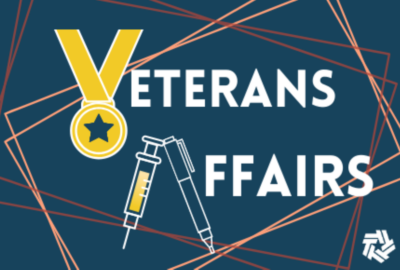VA leaders say fixing budget shortfall is ‘job one’ for Trump administration in transition talks
VA Secretary Denis McDonough said the VA has briefed the incoming Trump administration about the VA’s unaddressed budget shortfall.
The Department of Veterans Affairs is preparing the incoming Trump administration to take over its day-to-day operations, at a time when the department is seeing record demand for its health care and benefits.
VA Secretary Denis McDonough told reporters on Wednesday that the department is committed to delivering a “world-class transition” to the Trump team.
“They have the tools they need to hit the ground running on day one, and to make sure they have what they need to deliver for veterans,” McDonough said.
The Trump transition team signed a memorandum of understanding with the White House in late November that allowed landing teams to receive briefings from agencies. Last month, the team signed another memo with the Justice Department that allows Trump’s top political appointees to go through the security clearance process.
McDonough said the VA set up its transition team this past summer.
“Since the day of the election, we’ve been ready with detailed briefings and memos on every part of VA to help the incoming team,” he said.
The incoming Trump team, he added, received those documents the day the transition officially began, and that so far, the VA has held or scheduled 22 meetings with the incoming administration. McDonough said he last met with transition officials on Tuesday.
The department, he added, has closed out 74 of the transition team’s requests for information, and is working to fulfill an additional 80 requests.
“We’re responding to every question quickly and transparently. And we’re sharing everything we know with the transition team — detailed information about VA operations, risks, and opportunities,” McDonough said.
The VA’s briefing materials include details on its staffing, budget, plans to resume the rollout of a new Electronic Health Record and its physical infrastructure.
The department will see relatively little turnover under a new administration. The VA has fewer than 40 political positions and oversees the second-largest workforce in the federal government — second only to the Defense Department.
McDonough said he doesn’t expect the transition will have an impact on the VA workforce or veterans seeking VA’s services.
“When we talk about the workforce’s expectations, and most importantly, when we talk about veterans’ expectations, I think their expectation is that it be seamless. And we’ve taken that very seriously,” McDonough said.
Deputy VA Secretary Tanya Bradsher said the VA workforce is “delivering more care, more benefits, to more veterans than at any other time in history.”
“You’re delivering by meeting veterans where they are, rather than expecting them to come to VA. And it’s not just more veterans. It’s more veterans trusting VA at record rates that are remaining at an all-time high,” Bradsher said.
President-elect Donald Trump, however, expressed frustrations with the Biden administration on Tuesday, and told reporters the presidential transition is “not smooth.”
“They say we’re going to have a smooth transition. All they do is talk. It’s all talk. Everything they do is talk,” Trump said at a press conference at Mar a Lago.
VA budget shortfall ‘job one’ for Trump administration
McDonough said the VA has also briefed the incoming team about the VA’s unaddressed budget shortfall.
“We want the incoming team to understand the implications of that shortfall so that they will be prepared for the budget debate before the current CR expires in March,” McDonough said.
Congress approved a $3 billion supplemental in September to avoid delays in paying disability benefits and veterans and their survivors. But lawmakers have yet to address a multi-billion-dollar shortfall in the VA’s FY 2025 health care budget.
VA officials told lawmakers this summer that the Veterans Health Administration would need an additional $12 billion before the end of the fiscal year. But officials recently cut that estimate by nearly half, after they told lawmakers that a shortfall in its health care budget wasn’t as severe as earlier estimates showed.
Under Secretary for Health Shereef Elnahal said in a recent interview that the PACT Act, which expands eligibility for VA health care and benefits to veterans exposed to toxic substances during their military service, has “significantly increased demand in our system.”
Elnahal said VHA needs the funding to keep growing its workforce to keep pace with record demand for medical appointments, and to end a temporary pause on purchasing some medical devices.
Bradsher said addressing the department’s budget should be “job one” for the incoming Trump administration.
“Operating on a CR is definitely not ideal. Hopefully, our staff will be able to have a full ‘25 budget and be able [to start] that planning process as well as to make sure that the shortfalls that we’re currently looking at are identified,” Bradsher said.
Republican lawmakers have become increasingly skeptical of the VA’s requests for supplemental funding. House VA Committee Chairman Mike Bost (R-Ill.) said at a hearing last month that the VA’s shifting estimates for additional funding are “inexcusable.”
McDonough said the VA has asked for “significant increases” in its budget over the last four years, especially given its growing workload under the PACT Act.
“We’ve been very clear in how and where we spend that. When we’ve needed extra money, we’ve gone to the Hill to explain what it is we need it for, and why it is that we need it. And inevitably, we only need the extra funding because this is a veteran-centered organization, meaning we’re going to make every decision based on what the veterans need,” he said.
Meanwhile, the incoming Trump administration and its Department of Government Efficiency have talked about major funding cuts across the entire federal government.
“In terms of what the next administration chooses to do, those will be their decisions to address,” McDonough said.
VA hiring ‘near flat,’ but driving down wait times
Amid the VA’s budget constraints, McDonough said VHA’s workforce has plateaued at nearly 400,000 total employees, but added that VA clinicians are driving down wait times for medical appointments.
“We’re near flat for the last fiscal year, even as numbers of appointments have gone up to record highs. And that’s a function of productivity,” McDonough said.
McDonough said VHA is “making very concerted decisions about when, where, and whom to hire.”
The VA, he added, is looking to staff up on Veteran Readiness and Employment (VR&E) counselors to keep up with a “massive surge” in veterans seeking those job training and education benefits.
McDonough said the Veterans Benefits Administration’s workforce overall is keeping pace with its workload, and the VBA is setting new records year-over-year on the number of disability claims processed.
“We’re reaching the point now where we believe we can now begin to manage that ultimate workforce number through attrition … as we built up the workforce for the initial surge in claims under the PACT Act,” McDonough said.
The VA is seeing higher costs both for the health care it directly provides to veterans, and for the “community care” veterans receive from private, non-VA health care providers.
Meanwhile, Republican lawmakers are looking to expand on the 2018 MISSION Act, which gives veterans greater access to non-VA health care options that the department helps pay for.
McDonough said the future of VA’s role in health care “is a question of veterans’ preference.”
“One could see a period at which the demand for care in the community, for funding for appointments in the community, is so significant that you have to pull back on the amount of the budget you’re dedicating to hiring and maintaining VA providers, And so then the question is, if that is indeed a choice that we make as a country, that we would reduce the number of providers at VA, how would we do that? And what would be the rational basis for that? Would you just say that VA is going to get out of certain specialties? Would you rather say that VA is going to maintain the specialties but get out of primary care? Each of those would end up creating a different scenario for veterans, and each of those has significant costs.”
Next steps for EHR
The VA put all future deployments of its new Electronic Health Record on hold in April 2023 but is getting ready to resume deployments in mid-2026.
The department is planning to resume its rollout of a new Electronic Health Record in mid-2026, after spending a year and a half to address problems at sites already using it.
McDonough said the VA “learned some really important lessons in the reset,” and that the department’s most recent deployment at a medical facility it jointly runs with the Navy is a sign that the department is back on track with the project.
“We feel like we’re ready to go to the next level. So we’ve laid out what that plan will look like,” McDonough said.
Despite some multi-billion-dollar project’s shortcomings, McDonogh said a new EHR fully integrated with the Defense Department is key to providing better health care to veterans.
“My wish for our providers and for the VA system is that we not lose sight of the ‘why.’ And the ‘why’ is that veterans need an integrated modernized electronic health record for better health outcomes and for better and overall engagement with the VA. And by better, I mean more accurate claims determinations ultimately will be informed by this when it’s fully implemented,” McDonough said.
Bradsher said the VA is seeing a “dramatic decrease” in EHR outages and an increase in veteran trust scores.
“We’re moving in the right direction,” she said.
The VA plans for a mid-2026 launch of the Oracle-Cerner EHR at four VA facilities in Michigan — Ann Arbor, Battle Creek, Detroit and Saginaw.
Bradsher said the department will begin pre-deployment activities later this month.
“I really would love to see a time where that service member can just easily have all of their information and data when they go to their very first VA appointment, just pull up everything on their record. And that is the ultimate goal,” she said.
Copyright © 2025 Federal News Network. All rights reserved. This website is not intended for users located within the European Economic Area.
Jory Heckman is a reporter at Federal News Network covering U.S. Postal Service, IRS, big data and technology issues.
Follow @jheckmanWFED






